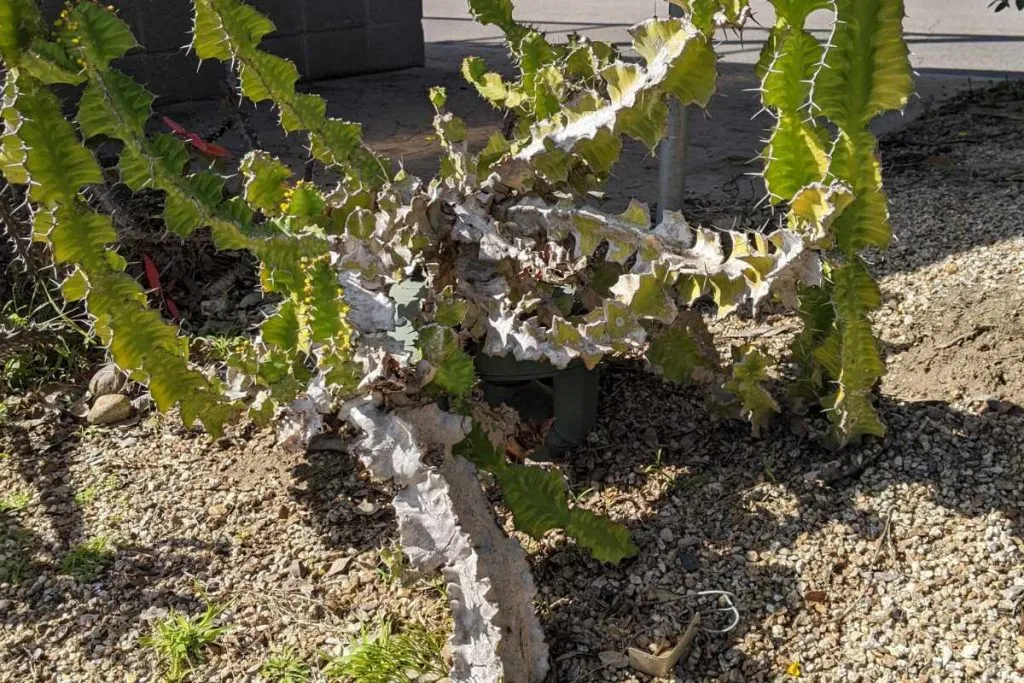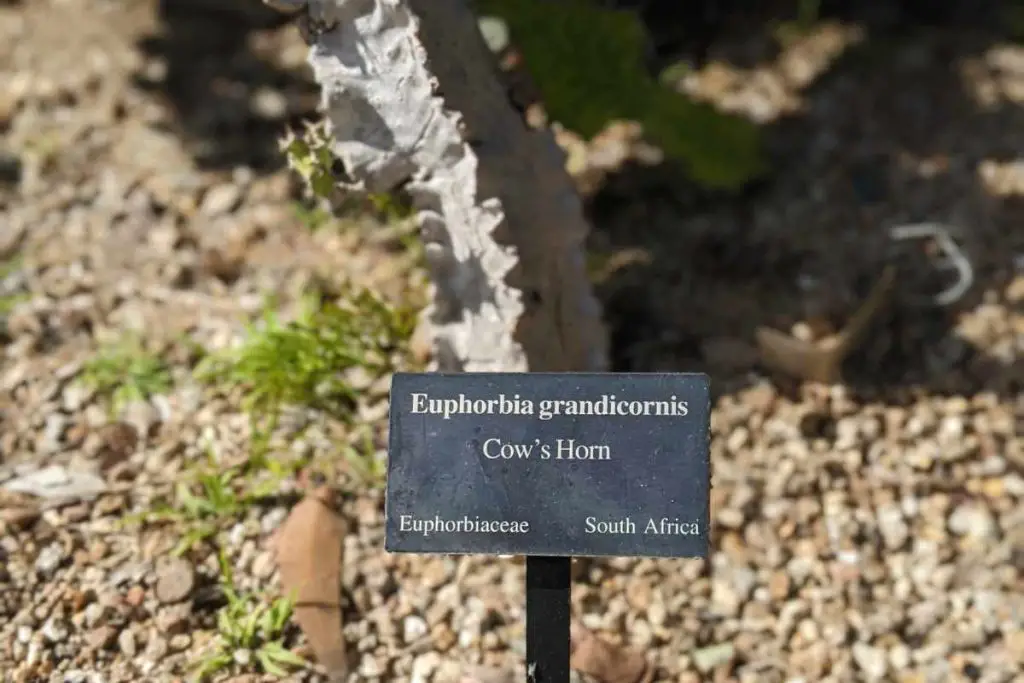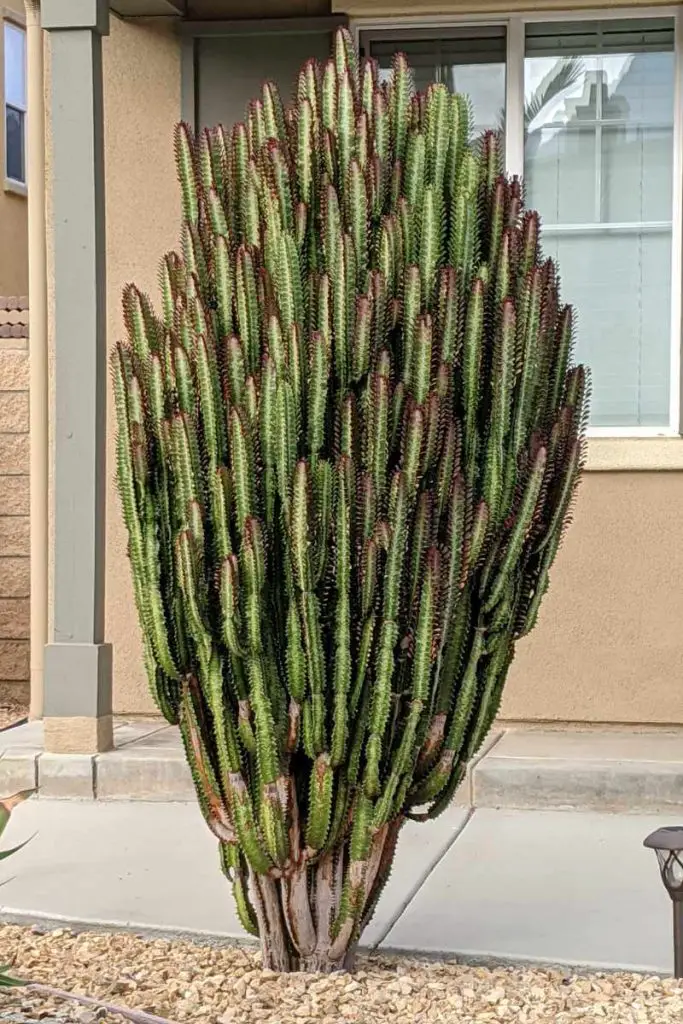Cactus corking is a common problem that affects many types of cactus plants as well as Euphorbia and soft succulents alike. It is a condition in which the plant’s stem becomes thickened and hardened, leading to a “corky” appearance. It can be caused by a variety of factors, including age, genetics, and environmental stress. In this post, we’ll take a closer look at cactus corking, including the causes, symptoms, and treatment options

Dig in!
Causes of Cactus Corking
Cactus corking is a natural process that occurs as cactus plants age. As the plant grows and matures, it will naturally produce a thickened, corky layer of tissue on its stem as a way to protect itself from environmental stress and damage. Some cactus species are more prone to corking than others, and certain environmental conditions, such as drought or extreme heat, can also contribute to the development of corking.
You might also like: 10 Cactus and Succulent Adaptations: How These Incredible Plants Have Adapted to Survive in Extreme Environments
Genetics and Environmental Stress
Genetics determines the genetic potential of a cactus to develop corking in response to environmental stress. Certain genetic traits may make a cactus more likely to develop corking in response to drought or other stressors.

Environmental stress, such as drought or exposure to high temperatures, triggers cactus corking as a protective mechanism. The cactus will produce a protective layer of cork cells on the stem and trunk, which helps to reduce water loss and protect the plant from damage. This cactus corking adaptation helps the cactus survive in harsh desert environments.

Therefore, both genetics and environmental stress play a part in determining whether a cactus will develop corking and how it will respond to environmental stress.
Symptoms of Cactus Corking
Cactus corking is a significant adaptation of cactus that helps the plant survive in harsh desert environments. It is easily recognizable by the thickened, corky appearance of the stem, which has a rough and hard texture and may differ in color from the surrounding tissue. This corky tissue acts as a protective layer that reduces water loss and helps to protect the plant from damage.

In addition to its protective function, corking can also impact the growth and shape of the cactus. In some cases, the development of corky tissue may cause the plant to become stunted or misshapen, altering its overall appearance. However, this does not necessarily impact the survival or health of the plant.
Cactus corking is a critical adaptation that allows cactus to thrive in harsh desert environments, where water is limited and temperature fluctuations are extreme. The development of corky tissue is triggered by environmental stress, such as drought or exposure to high temperatures, and is influenced by the plant’s genetics. Overall, cactus corking is an important adaptation that plays a crucial role in the survival and success of cactus in harsh desert environments.
Treatment Options
Cactus corking is a normal and natural adaptation for cactus plants, and it is not typically considered a serious problem. In most cases, cactus corking does not require any type of treatment and is simply a result of the plant’s response to environmental stress.
However, in some cases, the corky tissue may cause the plant to become misshapen or stunted, which can impact its overall appearance. In these instances, it may be necessary to remove the corky tissue in order to allow the plant to grow properly.

The removal of corky tissue should be done carefully and with a clean, sharp knife. It is important to be gentle when cutting away the corky tissue, as cactus plants are prone to damage and rot. If not handled carefully, the removal of corky tissue can increase the risk of injury or infection for the plant.
Overall, cactus corking is not a serious problem and does not typically require treatment. However, if the corking is causing the plant to become misshapen or stunted, it may be necessary to remove the corky tissue in order to allow the plant to grow properly.

Cactus corking is a common problem that affects many types of cactus plants. It is a natural process that occurs as the plant ages and is typically not a cause for concern. However, if the corking is causing the plant to become misshapen or stunted, it may be necessary to remove the corky tissue in order to allow the plant to grow properly. By understanding the causes, symptoms, and treatment options for cactus corking, you can help ensure that your cactus plants remain healthy and vigorous.
FAQs
How do you tell the difference between cactus corking and rot?
Corking is dry, slow, firm, and superficial while rot is moist, rapid, soft, and penetrates the plant. Recognizing the differences quickly can save the cactus!
Here are some tips to distinguish between corking and rot in cacti:
- Corking appears as brown or tan patches on the skin, often raised or cork-like in texture. It is dry and firm to the touch. Rot affected areas will be soft, moist, or mushy.
- Corking tends to start at the base and spread upwards. Rot usually starts at the top or in spots along the body.
- Corking is a very slow process, taking years to develop. Rot can happen quickly, especially if overwatered.
- Corking is a natural response to sun exposure and age, harmless to the cactus. Rot is tissue damage from poor growing conditions that can kill the plant.
- If you cut into corked areas, the inner flesh is still healthy and green. Inner flesh that is brown, yellow, or mushy indicates rot.
- Corking often forms defined hard patches. Rot typically looks water-soaked and spreads as patches get larger.
- With corking, only the outer skin is affected. Rot penetrates deep into the plant.
- Corked areas will feel firmly attached to the cactus. Rotted areas detach more easily from healthy flesh.
- Corking does not give off any odor. Rotted cacti usually develop a foul, decomposing smell.

